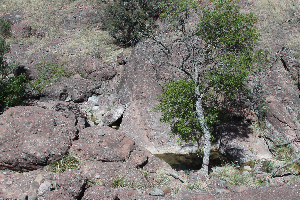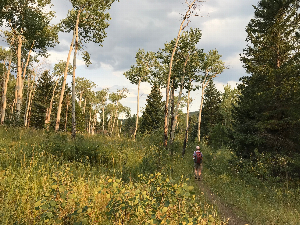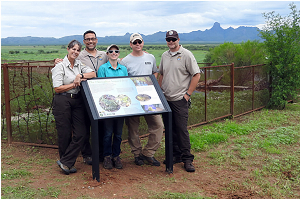Search ARMI Database
Search term(s)
Contribution Number
Search Results
180 record(s) found.
Papers & Reports Conservation decisions under pressure: lessons from an exercise in rapid response to wildlife disease
News & Stories ARMI scientists participate in International Symposium: Amphibian population declines – 30 years of progress in confronting a complex problem. Montreal, Canada
Scientists first became concerned that the observations of declining or lost amphibian populations were not isolated incidents but were global in scope and severity at the landmark 1st World Congress of Herpetology in Canterbury England in 1989. The plight of amphibians became front-page news and the newly generated interest in their population biology generated a massive increase in our understanding of their ecology, epidemiology and conservation biology. To mark 30 years of research into amphibian population declines, the Redpath Museum and McGill University in Montreal held an international symposium on amphibian ecology and conservation biology to bring together many of the principle researchers now making significant advances in the field. Evan Grant and Erin Muths, Principle Investigators for ARMI, were invited participants to the symposium held in September. Dr. Grant presented a lecture on lessons from broad-scale synthetic analyses about drivers of decline and Dr. Muths presented on the effects of disease, temperature, and community on demography and how analytical advances allow us to address more complex questions about decline. Both topics will be featured manuscripts in the forthcoming special issue of the journal Herpetologica.
Papers & Reports Estimating metapopulation abundance to inform conservation of a threatened amphibian
Papers & Reports Species-specific responses to wetland mitigation among amphibians in the Greater Yellowstone Ecosystem
Papers & Reports A continuum of risk tolerance: Reintroductions of toads in the Rockies
Papers & Reports Integrating amphibian movement studies across scales better informs conservation decisions
Papers & Reports Conservation research across scales in a national program: how to be relevant to local management yet general at the same time
Papers & Reports Effect of amphibian chytrid fungus (Batrachochytrium dendrobatidis) on apparent survival of frogs and toads in the western USA
Papers & Reports Distribution of tiger salamanders in northern Sonora, Mexico: comparison of sampling methods and possible implications for an endangered subspecies
distributions and threats often hinders management. To provide information on the distribution of the Western Tiger
Salamander (Ambystoma mavortium), including the USA-federally endangered Sonoran Tiger Salamander (Ambystoma
mavortium stebbinsi), we used traditional (seines, dip-nets) and modern (environmental DNA [eDNA]) methods to sample
91 waterbodies in northern Sonora, Mexico, during 2015-2018. The endemic Sonoran Tiger Salamander is threatened by
introgressive hybridization and potential replacement by another sub-species of theWestern Tiger Salamander, the non-native
Barred Tiger Salamander (A. m. mavortium). Based on occupancy models that accounted for imperfect detection, eDNA
sampling provided a similar detection probability (https://0.82 [95% CI: 0.56-0.94]) as seining (https://0.83 [0.46-0.96]) and much higher
detection than dip-netting (https://0.09 [0.02-0.23]). Volume of water filtered had little effect on detection, possibly because turbid
sites had greater densities of salamanders. Salamanders were estimated to occur at 51 sites in 3 river drainages in Sonora.
These results indicate tiger salamanders are much more widespread in northern Sonora than previously documented, perhaps
aided by changes in land and water management practices. However, because the two subspecies of salamanders cannot be
reliably distinguished based on morphology or eDNA methods that are based on mitochondrial DNA, we are uncertain if we
detected only native genotypes or if we documented recent invasion of the area by the non-native sub-species. Thus, there is
an urgent need for methods to reliably distinguish the subspecies so managers can identify appropriate interventions.
Papers & Reports Hanging by a Thread: Recovery of Reintroduced Chiricahua Leopard Frogs after Bullfrog Eradication in an Intensively Managed Landscape
Papers & Reports Using Full and Partial Unmixing Algorithms to Estimate the Inundation Extent of Small, Isolated Stock Ponds in an Arid Landscape
Papers & Reports A statistical forecasting approach to metapopulation viability analysis
Papers & Reports Survival cost to relocation does not reduce population self-sustainability in an amphibian
Papers & Reports Amphibian conservation in the Anthropocene
Papers & Reports Drought-mediated extinction of an arid-land amphibian: insights from a spatially explicit dynamic occupancy model
Papers & Reports Identifying management-relevant research priorities for responding to disease-associated amphibian declines
News & Stories Exploring the amphibian exposome in an agricultural landscape using telemetry and passive sampling
USGS and Iowa State University scientists quantified Northern Leopard frog exposure to pesticides in aquatic and terrestrial habitats using a novel combination of radio telemetry and passive sampling techniques to better understand factors affecting frog health and survival in agricultural landscapes. The results of this newly published research can inform conservation strategies by providing information about when and where the frogs are most likely exposed to pesticides. This unique approach can be utilized in other land-use settings and with other amphibian species to better understand if contaminant exposure affects growth, development, fitness, and survival.
Full article is available here: https://www.nature.com/articles/s41598-018-28132-3






